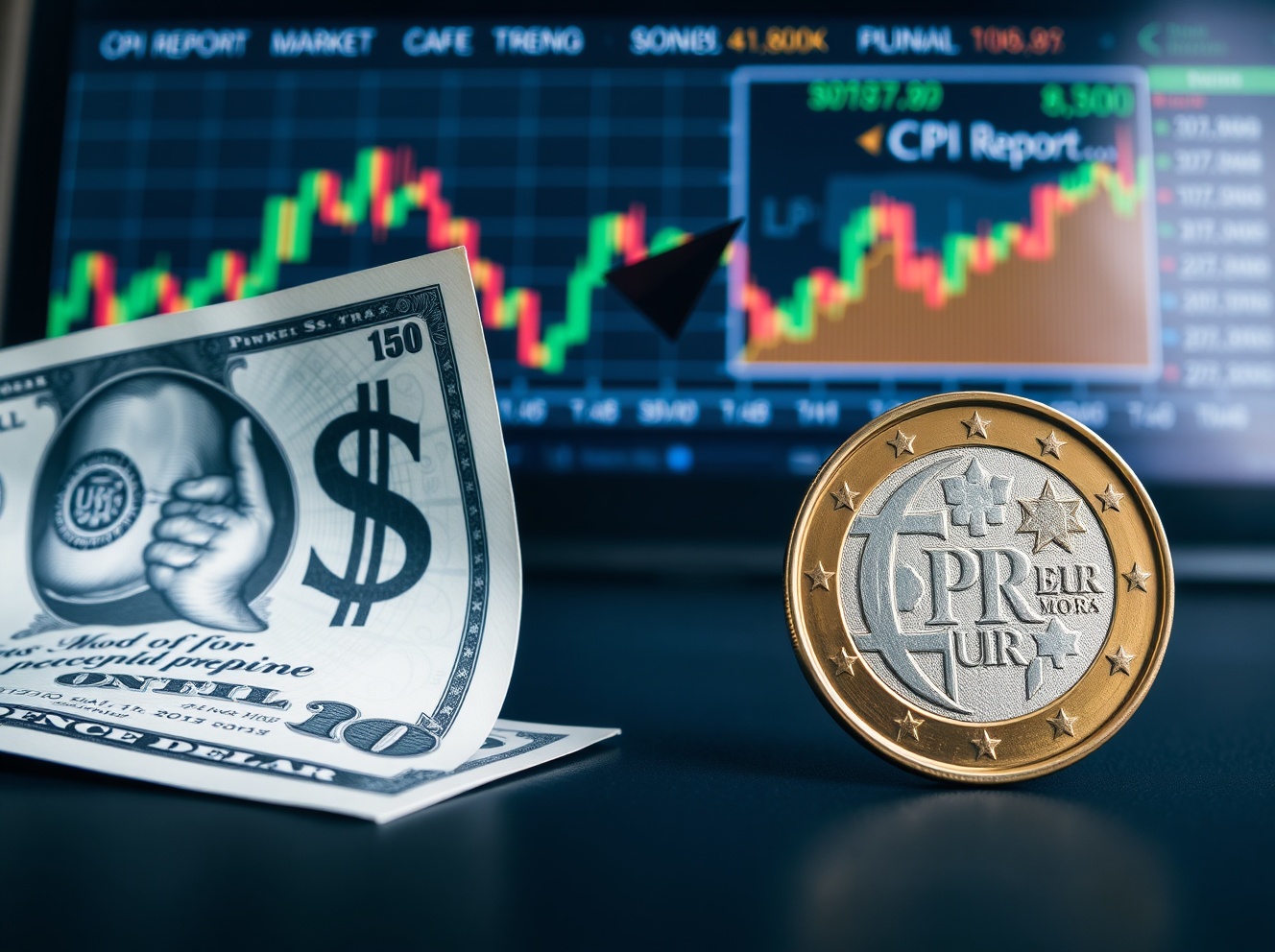US CPI Data: Surprising September Rise Below Forecast, What it Means for Crypto

BitcoinWorld
US CPI Data: Surprising September Rise Below Forecast, What it Means for Crypto
The latest economic news often sends ripples through the financial world, and the cryptocurrency market is no exception. Recently, the U.S. Department of Labor released crucial US CPI data for September, revealing a year-over-year increase of 3.0%. This figure, while still showing inflation, actually came in below the market’s forecast of 3.1%. What does this surprising development mean for your digital asset portfolio and the broader economic landscape?
Understanding the Latest US CPI Data: A September Snapshot
The Consumer Price Index (CPI) is a vital economic indicator that measures the average change over time in the prices paid by urban consumers for a market basket of consumer goods and services. Essentially, it tells us how much more or less expensive everyday items are becoming. The September US CPI data showed a 3.0% rise compared to the same month last year.
- Below Forecast: Experts had predicted a 3.1% increase, so 3.0% was a slight relief.
- Annual Trend: While 3.0% is still a significant rise, it suggests a potential cooling trend compared to higher inflation rates seen in previous periods.
- Core CPI: Often, analysts also look at “Core CPI,” which excludes volatile food and energy prices, to get a clearer picture of underlying inflation.
This subtle difference in the US CPI data can have profound implications for monetary policy and investor sentiment.
What Does This US CPI Data Mean for Inflation?
Inflation has been a dominant theme in global economics for some time, influencing everything from interest rates to investment strategies. When the US CPI data comes in lower than expected, it can signal that inflationary pressures might be easing. This is generally a positive sign, as sustained high inflation erodes purchasing power and can lead to economic instability.
However, it is important to remember that 3.0% is still above the Federal Reserve’s long-term target of 2%. Therefore, while the September figures offer a glimmer of hope, the fight against inflation is far from over. The Federal Reserve closely monitors these numbers when deciding on future interest rate adjustments.
Lower-than-expected inflation could potentially lead to a less aggressive stance from the Fed, which often has a significant impact on risk assets like cryptocurrencies.
The Crypto Market’s Reaction to US CPI Data
The cryptocurrency market, known for its volatility, often reacts strongly to macroeconomic news, especially inflation reports. When inflation is high and persistent, central banks tend to raise interest rates to cool the economy. Higher interest rates make traditional savings accounts and bonds more attractive, potentially drawing capital away from riskier assets like Bitcoin and Ethereum.
Conversely, signs of easing inflation, as hinted by the latest US CPI data, can be seen as a positive for crypto. If the Fed becomes less hawkish, the likelihood of a “soft landing” for the economy increases, and investors might feel more confident in allocating capital to growth-oriented and speculative assets.
Key Considerations for Crypto Investors:
- Interest Rate Expectations: Will this data influence the Fed’s next move?
- Investor Confidence: Does it encourage a return to risk assets?
- Dollar Strength: Inflation data also impacts the U.S. Dollar Index (DXY), which can inversely affect crypto prices.
It is crucial to observe how the market digests this information in the coming days and weeks.
Navigating Your Investments Amidst Evolving US CPI Data
For those invested in the dynamic world of digital assets, understanding economic indicators like the US CPI data is paramount. While cryptocurrencies offer unique value propositions, they are not immune to broader economic forces. Here are some actionable insights:
- Stay Informed: Continuously monitor economic reports and central bank communications.
- Diversify: Do not put all your eggs in one basket. A diversified portfolio can mitigate risks.
- Long-Term Perspective: Volatility is inherent in crypto. Focus on your long-term investment goals rather than short-term fluctuations.
- Risk Management: Only invest what you can afford to lose and set clear entry and exit strategies.
The September CPI figures provide a nuanced picture, suggesting that while inflation remains a factor, it may not be accelerating as rapidly as once feared. This could create a more favorable environment for innovation and growth in the crypto space.
In conclusion, the September US CPI data, showing a 3.0% year-over-year rise that was below forecast, offers a fascinating glimpse into the current state of the U.S. economy. While it hints at a potential deceleration in inflationary pressures, the journey to price stability continues. For cryptocurrency enthusiasts and investors, these economic signals are vital, shaping market sentiment and influencing investment decisions. Staying informed and adopting a strategic approach will be key to navigating the evolving financial landscape.
Frequently Asked Questions (FAQs)
1. What is the Consumer Price Index (CPI)?
The CPI measures the average change over time in the prices paid by urban consumers for a basket of consumer goods and services. It is a key indicator of inflation.
2. Why is the September US CPI data significant?
The September US CPI data is significant because it came in below market forecasts, suggesting that inflationary pressures might be easing, which could influence the Federal Reserve’s monetary policy decisions.
3. How does US CPI data affect the cryptocurrency market?
Lower-than-expected US CPI data can be seen positively by the crypto market, as it might lead to a less aggressive stance from central banks regarding interest rate hikes, making risk assets like cryptocurrencies more attractive.
4. Will this CPI report stop the Federal Reserve from raising interest rates?
While the lower-than-forecast US CPI data offers some relief, 3.0% inflation is still above the Fed’s 2% target. It may lead to a less aggressive approach, but it does not guarantee an end to rate hikes. The Fed considers a range of economic factors.
5. What should crypto investors do after this CPI report?
Crypto investors should remain informed, consider diversifying their portfolios, maintain a long-term perspective, and practice sound risk management. Economic indicators like the US CPI data are just one piece of the puzzle.
Did you find this analysis of the US CPI data insightful? Share this article with your friends and fellow investors on social media to help them understand the crucial economic trends impacting the crypto world!
To learn more about the latest crypto market trends, explore our article on key developments shaping Bitcoin price action.
This post US CPI Data: Surprising September Rise Below Forecast, What it Means for Crypto first appeared on BitcoinWorld.
US CPI Data: Surprising September Rise Below Forecast, What it Means for Crypto

BitcoinWorld
US CPI Data: Surprising September Rise Below Forecast, What it Means for Crypto
The latest economic news often sends ripples through the financial world, and the cryptocurrency market is no exception. Recently, the U.S. Department of Labor released crucial US CPI data for September, revealing a year-over-year increase of 3.0%. This figure, while still showing inflation, actually came in below the market’s forecast of 3.1%. What does this surprising development mean for your digital asset portfolio and the broader economic landscape?
Understanding the Latest US CPI Data: A September Snapshot
The Consumer Price Index (CPI) is a vital economic indicator that measures the average change over time in the prices paid by urban consumers for a market basket of consumer goods and services. Essentially, it tells us how much more or less expensive everyday items are becoming. The September US CPI data showed a 3.0% rise compared to the same month last year.
- Below Forecast: Experts had predicted a 3.1% increase, so 3.0% was a slight relief.
- Annual Trend: While 3.0% is still a significant rise, it suggests a potential cooling trend compared to higher inflation rates seen in previous periods.
- Core CPI: Often, analysts also look at “Core CPI,” which excludes volatile food and energy prices, to get a clearer picture of underlying inflation.
This subtle difference in the US CPI data can have profound implications for monetary policy and investor sentiment.
What Does This US CPI Data Mean for Inflation?
Inflation has been a dominant theme in global economics for some time, influencing everything from interest rates to investment strategies. When the US CPI data comes in lower than expected, it can signal that inflationary pressures might be easing. This is generally a positive sign, as sustained high inflation erodes purchasing power and can lead to economic instability.
However, it is important to remember that 3.0% is still above the Federal Reserve’s long-term target of 2%. Therefore, while the September figures offer a glimmer of hope, the fight against inflation is far from over. The Federal Reserve closely monitors these numbers when deciding on future interest rate adjustments.
Lower-than-expected inflation could potentially lead to a less aggressive stance from the Fed, which often has a significant impact on risk assets like cryptocurrencies.
The Crypto Market’s Reaction to US CPI Data
The cryptocurrency market, known for its volatility, often reacts strongly to macroeconomic news, especially inflation reports. When inflation is high and persistent, central banks tend to raise interest rates to cool the economy. Higher interest rates make traditional savings accounts and bonds more attractive, potentially drawing capital away from riskier assets like Bitcoin and Ethereum.
Conversely, signs of easing inflation, as hinted by the latest US CPI data, can be seen as a positive for crypto. If the Fed becomes less hawkish, the likelihood of a “soft landing” for the economy increases, and investors might feel more confident in allocating capital to growth-oriented and speculative assets.
Key Considerations for Crypto Investors:
- Interest Rate Expectations: Will this data influence the Fed’s next move?
- Investor Confidence: Does it encourage a return to risk assets?
- Dollar Strength: Inflation data also impacts the U.S. Dollar Index (DXY), which can inversely affect crypto prices.
It is crucial to observe how the market digests this information in the coming days and weeks.
Navigating Your Investments Amidst Evolving US CPI Data
For those invested in the dynamic world of digital assets, understanding economic indicators like the US CPI data is paramount. While cryptocurrencies offer unique value propositions, they are not immune to broader economic forces. Here are some actionable insights:
- Stay Informed: Continuously monitor economic reports and central bank communications.
- Diversify: Do not put all your eggs in one basket. A diversified portfolio can mitigate risks.
- Long-Term Perspective: Volatility is inherent in crypto. Focus on your long-term investment goals rather than short-term fluctuations.
- Risk Management: Only invest what you can afford to lose and set clear entry and exit strategies.
The September CPI figures provide a nuanced picture, suggesting that while inflation remains a factor, it may not be accelerating as rapidly as once feared. This could create a more favorable environment for innovation and growth in the crypto space.
In conclusion, the September US CPI data, showing a 3.0% year-over-year rise that was below forecast, offers a fascinating glimpse into the current state of the U.S. economy. While it hints at a potential deceleration in inflationary pressures, the journey to price stability continues. For cryptocurrency enthusiasts and investors, these economic signals are vital, shaping market sentiment and influencing investment decisions. Staying informed and adopting a strategic approach will be key to navigating the evolving financial landscape.
Frequently Asked Questions (FAQs)
1. What is the Consumer Price Index (CPI)?
The CPI measures the average change over time in the prices paid by urban consumers for a basket of consumer goods and services. It is a key indicator of inflation.
2. Why is the September US CPI data significant?
The September US CPI data is significant because it came in below market forecasts, suggesting that inflationary pressures might be easing, which could influence the Federal Reserve’s monetary policy decisions.
3. How does US CPI data affect the cryptocurrency market?
Lower-than-expected US CPI data can be seen positively by the crypto market, as it might lead to a less aggressive stance from central banks regarding interest rate hikes, making risk assets like cryptocurrencies more attractive.
4. Will this CPI report stop the Federal Reserve from raising interest rates?
While the lower-than-forecast US CPI data offers some relief, 3.0% inflation is still above the Fed’s 2% target. It may lead to a less aggressive approach, but it does not guarantee an end to rate hikes. The Fed considers a range of economic factors.
5. What should crypto investors do after this CPI report?
Crypto investors should remain informed, consider diversifying their portfolios, maintain a long-term perspective, and practice sound risk management. Economic indicators like the US CPI data are just one piece of the puzzle.
Did you find this analysis of the US CPI data insightful? Share this article with your friends and fellow investors on social media to help them understand the crucial economic trends impacting the crypto world!
To learn more about the latest crypto market trends, explore our article on key developments shaping Bitcoin price action.
This post US CPI Data: Surprising September Rise Below Forecast, What it Means for Crypto first appeared on BitcoinWorld.

